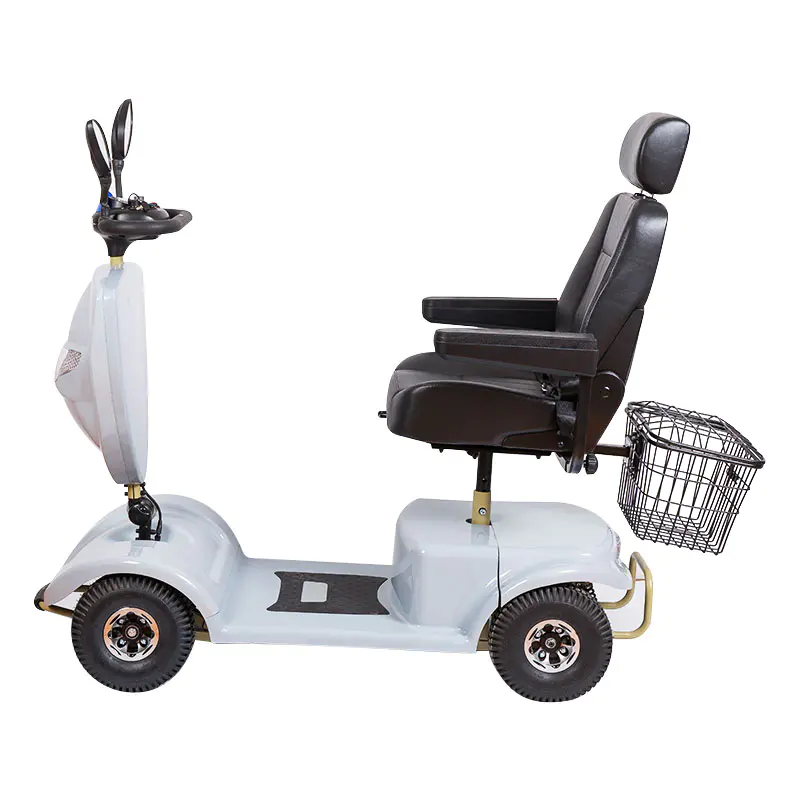What are the most important safety features to consider when buying a elderly mobility scooter?
When buying an elderly mobility scooter, safety is a top priority. Here are the most important safety features to consider:
Stability and Balance
Wheel Configuration: Look for scooters with a stable wheelbase and proper wheel configuration. Four-wheeled scooters generally offer better stability than three-wheeled models.
Low Center of Gravity: A low center of gravity helps prevent tipping and provides better balance, especially when navigating uneven surfaces or making turns.
Braking System
Reliable Brakes: Ensure the scooter has reliable and responsive brakes. Look for scooters with both electronic and manual brakes for added safety.
Emergency Brakes: Some models feature automatic braking systems that engage in case of emergencies or sudden stops.
Speed Control
Adjustable Speed: Check if the scooter has adjustable speed settings so you can control the speed based on your comfort level and safety needs.
Speed Limiting Features: Some scooters come with built-in speed limiters to prevent driving too fast, which can be particularly useful for maintaining safety in crowded or complex environments.
Lighting and Reflectors
Front and Rear Lights: Good visibility is crucial, so ensure the scooter has front and rear lights. This is especially important for driving in low-light conditions or at night.
Reflectors: Reflectors on the scooter’s sides and rear enhance visibility and safety for other drivers and pedestrians.
Safety Harness and Seating
Safety Belt: A safety harness or seatbelt can help keep the user securely in place, reducing the risk of falling or being thrown from the scooter.
Comfortable Seat: The seat should be well-cushioned, adjustable, and provide adequate back support to reduce the risk of discomfort or strain during use.
Tires and Suspension
Anti-Tip Tires: Anti-tip wheels or tires can help prevent the scooter from tipping over, especially on inclines or uneven surfaces.
Suspension System: A good suspension system helps absorb shocks and bumps, providing a smoother and safer ride.

Control and Steering
Easy-to-Use Controls: The controls should be easy to operate, with intuitive buttons or levers that are accessible and responsive.
Adjustable Steering: Adjustable steering columns or handlebars allow for a more customized and comfortable driving position.
Weather Resistance
Waterproofing: Check if the scooter has weather-resistant features, such as waterproof electronics and sealed connections, to protect it from rain and other elements.
Weatherproof Covers: Some scooters come with or offer optional covers to protect against rain and dust.
Parking Brake
Manual Parking Brake: A manual parking brake helps keep the scooter stationary when parked, reducing the risk of unintended movement.
Automatic Parking Brake: Some scooters feature automatic parking brakes that engage when the scooter is stopped, providing additional safety.
User Alerts and Indicators
Battery Indicator: A clear battery indicator or low-battery warning system helps ensure you never run out of power unexpectedly.
Error Alerts: Look for scooters with built-in diagnostic tools or alerts that notify you of any mechanical issues or malfunctions.
Backup and Reverse Features
Reverse Function: A reverse function allows users to back up safely, often with a beep or alert to signal the movement.
Rearview Mirrors: Rearview mirrors or cameras can help users see behind them and avoid collisions while reversing.
Durability and Build Quality
Robust Construction: The scooter should be made of durable materials and designed to withstand regular use and various terrain types.
Weight Capacity: Ensure the scooter can support the user's weight comfortably and safely.
Training and User Manuals
Instructional Manual: A comprehensive user manual with safety instructions and operating guidelines is essential for understanding how to use the scooter safely.
Training Programs: Some manufacturers offer training or demonstrations to help new users learn how to operate their scooters safely.
Considering these safety features will help ensure that the mobility scooter provides reliable, secure, and comfortable transportation, reducing the risk of accidents and improving overall user confidence.


 English
English Deutsch
Deutsch







-3.jpg?imageView2/2/format/jp2)
.jpg?imageView2/2/format/jp2)






